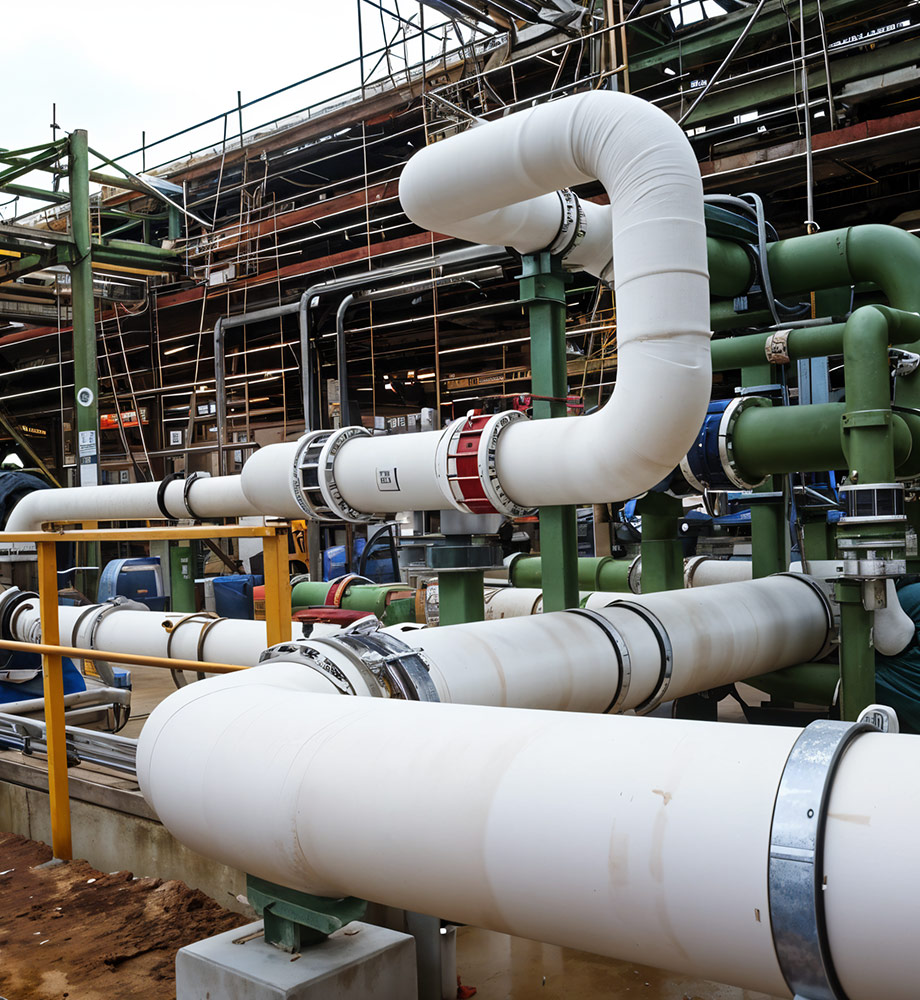Key Features
- Double Corrosion Barrier: The thermoplastic liner provides a continuous, impervious barrier to chemicals, while the thick outer FRP gives mechanical strength. Leaks or permeation through the liner are practically impossible under normal conditions.
- Wide Chemical Compatibility: Liner resins like PP, PVC, PVDF, ECTFE, FEP, and PFA cover almost all acids, alkalis, organic solvents and process fluids. For example, PVDF lining enables handling strong acids at elevated temperatures.
- High Pressure Capability: FRP reinforcement allows pressure ratings much higher than solid plastic pipe of the same size. TL-FRP pipe can often handle tens of bar pressures (depending on pipe diameter and laminate schedule) at ambient and elevated temperature.
- Abrasion Resistance: The hard plastic liner resists erosion from slurries or particulate-laden fluids. The FRP shell can include abrasion-resistant (AR) resin layers for even more rugged service.
- Fire & UV Safe: Many liners (PVDF, ETFE) have excellent fire resistance, and the FRP outer layer can be UV-stabilized for outdoor exposure.
Benefits
- Combined Advantages: Thermoplastic lined FRP merges the best of both worlds – the liner stops corrosion just as well as an all-plastic pipe, while the FRP provides stiffness and toughness like steel. This often yields lower total cost than all-metal (lined) solutions.
- Leak Safety: Since the liner is fully encapsulated, any damage is contained. Some manufacturers add a conductive layer at the liner–FRP interface so that any breach can be electrically detected during pressure testing or via monitoring (Sunrise notes this conductive layer ensures easy leak detection).
- Lightweight Compared to Solid Plastic: TL-FRP pipe can be significantly lighter than solid plastic pipe of the same pressure rating, easing handling.
- Long Service with Minimal Maintenance: The FRP shell protects the liner from mechanical damage, and the liner protects the FRP from chemicals. Together, they require minimal upkeep in harsh plant conditions.
Applications
Thermoplastic lined FRP is widely used where extremely corrosive chemicals are present, such as acid and alkali pipelines in chemical plants, pickling and plating lines, and waste chemical transfer. Common uses include ducting process acids (using PVC/CPVC liners), transport of organic solvents (PP or PVDF lined), and distribution of hypochlorite or bleach solutions. TL-FRP is also found in plating and metal finishing facilities (e.g. PVC-lined pipes for acid wash), chlor-alkali plants (FRP tanks and transfer lines), and in the mining industry for acid leachate lines. Whenever full thermoplastic pipe cannot economically meet structural or pressure needs, TL-FRP provides a customized solution.
Technical Specifications
- Liner Materials: Polypropylene (PP-H/PP-L), PVC/CPVC, PVDF, ECTFE, FEP, PFA, ETFE, PE etc., chosen per fluid and temperature.
- FRP Shell: Layers of fiberglass (woven roving, chopped strand mat, veils) impregnated in a resin (polyester, vinylester, epoxy). Typically wound or contact-laminated to precise thickness based on pressure class.
- Bonding: The liner interior is prepared (abraded or etched) and a proprietary adhesive or cloth is used so the FRP and plastic fuse into a monolithic wall.
- Pressure/Temp Ratings: As liners and resins vary, each TL-FRP system is rated by its weakest material. For example, PP-lined FRP might handle ~4–10 bar at room temperature; PVDF-lined FRP can go higher. Consult manufacturers or standards (like ASTM D3262 for dual-laminate) for exact ratings.
- Sizes: Often covers DN50–DN300 (2″–12″) as common, but large sizes are possible. Flanged ends are standard; butt-welded plastic flanges can be co-molded on the ends.
- Standards: Manufacturer designs follow ASTM D3262 / D3567 / D3519 (thermoplastic pressure pipe) combined with ASTM D2996 (reinforced pipe) guidelines.
Unique Selling Points (USPs)
- Ultimate Corrosion Protection: A TL-FRP pipe can handle near-any chemical: e.g. PP liners for sulfuric or hydrochloric acids up to ~100°C, PVDF for strong acids and oxidizers, and FEP/PFA for the toughest alkalis and organics.
- Higher Strength than Solid Plastic: Because the pressure is carried by FRP, a TL-FRP line can be thinner and lighter than pure plastic pipe of the same nominal size, yet often withstand higher pressures.
- Custom Engineering: Systems can be engineered with intermediate layers or special veils for aggressive media, plus colored liners/shells for fluid identification. Conductive liner layers are an option for early leak detection.
- Cost-Effective Replacement: When replacing corroded metal piping, TL-FRP often fits existing flanges and layouts. The adhesive bond between layers eliminates any gap that could corrode.

